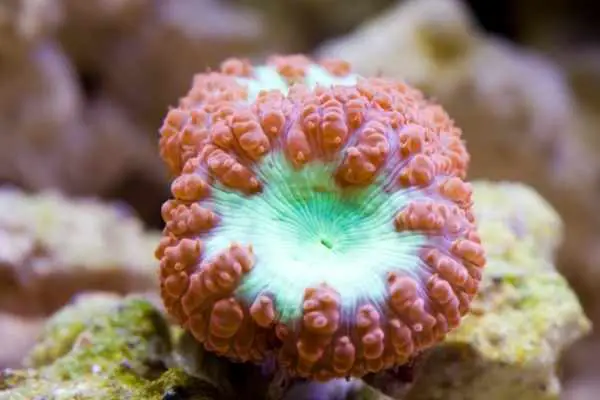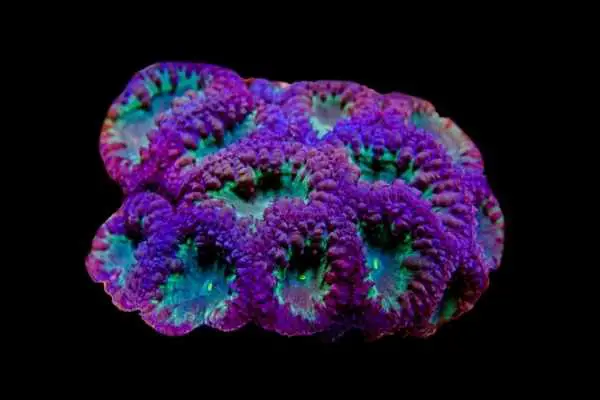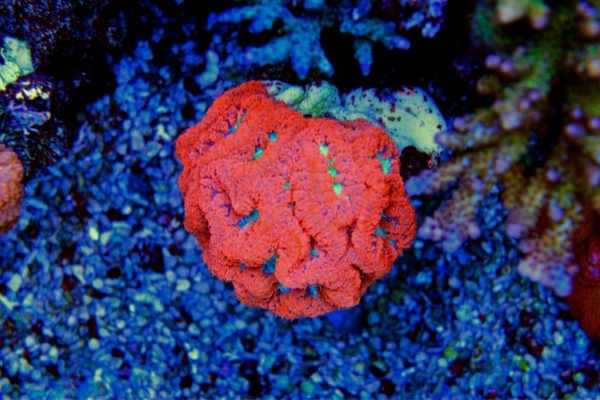The blastomussa coral (Blastomussa spp.) group produces as much confusion as it does popularity. The impressive polyps these large polyp stony (LPS) corals extend into the water disguise the underlying calcium skeleton. And they give it a similar appearance to mushroom, brain, and even candy cane corals. It isn’t until those polyps retract that you spot the unique structures underneath and realize you have a blastomussa. And the game of “Which coral is this?” It’s the tip of the iceberg when it comes to caring for blastos.
Table of Contents: Blastomussa Coral Care
Blastomussa corals fall on the list of “approved for beginners.” As you’ll find in the links below, they’re not overly demanding in their care. However, you won’t find first-time hobbyists lining up to purchase blastos. Enough quirks (including price!) cause people to pause and consider other LPS options first.
- Quick Facts
- Description of the Blastomussa Coral
- Creating the Ideal Blasto World
- Blastomussa Coral Feeding
- Blastomussa Coral Behavior and Tank Mates
- Blastomussa Coral Reproduction and Fragging
- Pros and Cons
- For More Information

Blastos Quick Facts:
- Common Names: Blastomussa coral, Big polyp coral, Pineapple coral, Blastos, Posy coral, Open brain coral, Swollen brain coral, Wellsi’s brain coral, Big pipe, Moon coral
- Scientific Names: Blastomussa spp.
- Size: Individual polyps reach 1-5 inches (2.5-12.7cm) in diameter
- Minimum Tank Size: 30 Gallons (114L)
- Aggression Level: Peaceful
- Compatibility: Should not be placed with other corals; They don’t possess strong enough defenses
- Care or Experience Level: Easy-Moderate
- Feeding Recommended? For ideal growth
- Lighting: Low-Moderate
- Water Flow: Low
- Original Part of the World: Indo-Pacific
Description of the Blastomussa Coral
As with most LPS corals, the blastomussa coral starts with a skeleton of calcium carbonate. Unlike their cousins, though, blastos don’t form typical colonies. Instead of having corallites branch out of a central base, the corallites divide into individual tubes. Each disc is a genetic clone of the one beside it. They form dome-shaped clusters on the seafloor, and when the polyps retract, you can spot the separate structures. It’s what sets these corals apart.
At first glance, though, it’s easy to mistake them for other species. Blastomussa merletti possess small polyps (1-2 inches/2.5-5cm) that put people in mind of zoas. Underneath the swollen discs, you get long brittle tubes. (Not a typical feature on a zoanthid) In contrast, Blastomussa wellsi‘s polyps are broader (4-5 inches/10.2-12.7cm) and resemble mushroom anemones. Their skeletons aren’t as long or delicate, though. (This makes them the more popular option with aquarists)
B. merletti and B. wellsi are the usual species kept in saltwater aquariums. That doesn’t mean you WON’T see one of the other four species show up in a fish store now and then, though. Although the newest member of the group – B. angulares – probably won’t make an appearance. Scientists only announced the discovery in February 2021. Since all corals create different shapes for their corallite skeletons, it went overlooked for – well, a long time.
The mouth on the oral disc usually comes in a different color from the tentacles. As the corallites cluster together, the contrast creates a “brain” pattern that gives blastos their common name of open brain coral. (Not to be confused with brain corals – though the similarity IS there) In the wild, you find them in shades of blue, brown, green, and red. But popularity – and the ease of fragging – has led to other purple, yellow, and pink options.

Creating the Ideal Blastos World
Blastos corals show up throughout reefs in the Indo-Pacific. You can spot them at popular dive spots around Fiji, the Great Barrier Reef, the Solomon Islands, and Tonga. (And, of course, that new addition to the genus calls the Indian Ocean home) Indonesia claims some of the most unique color variations.
The corals cluster along the upper slopes of a reef where the current’s at a low point. And they range reasonably deep into the water, going down to 130 feet (40m). They provide shelter for sessile mollusks, sponges, and other invertebrates. But you won’t see them in the company of too many other corals. And it ISN’T for the reason you think. (We’ll get to that in a second)
Blastos prefer to attach themselves to rock structures over sand. As such, you’ll want to have live rock handy. They do beautifully as centerpieces in reef tanks. And that dome shape looks perfect at the bottom of your tank. You just don’t want sand causing damage to the polyps. (Brown jelly disease is never fun)
Blastos Coral Tank Size
Blastomussa corals don’t swarm tanks the way other LPS corals tend to. The tubes of the corallites form up and out. As such, they don’t enact hostile takeovers of the aquarium. So regardless of the species you settle on, you can usually get away with a tank size of 30 gallons (114L).
That said, you need to allow room for your blasto within the tank. Placement of ANY coral is crucial. But blastos don’t have the fighting power of their cousins. If you crowd them into a tight space, you’ll end up with a lovely calcium skeleton in the middle of your aquarium. (At least until it dissolves) Make sure you give your coral colonies space to grow – without interference.

Water Parameters
As you’d expect from a beginner LPS coral, you don’t need to fret much on your water parameters. Blastomussa corals do well with standard saltwater aquarium conditions:
- Temperature: 76-81F (24.4-27.2C)
- Salinity: 1.023-1.025
- Alkalinity: 8-11dKH
- pH: 8.2-8.4
- Calcium: 400-450ppm
- Magnesium: 1200-1350ppm
You should also consider adding strontium to your water. A range of 8-10ppm will encourage the growth of your blastos. You can always dose your tank to keep your minerals in check.
Most important, though, are your calcium and magnesium. Without calcium, blastomussa corals can’t build their skeletons. And since magnesium and calcium balance one another, you need to pay attention to BOTH variables. If you do not see continued growth of your blastos, run a quick check on those parameters. You may need to make adjustments.
Where to place Blastomussa coral?
The ideal placement for Blastos is on the sand bed or glass bottom of the tank in an area of moderate flow and lighting.
Out on the reef, blastos prefer a moderate range of sunlight. You don’t see them in shallow waters where they receive the full impact of the sun. And the same goes for your tank. You want a moderate or even subdued lighting scheme. This will encourage them to open the polyps and extend them fully. (You’ll also get the best color out of your little coral – hint, hint)
If you place them in strong or intense lighting, two possible situations can occur. You can either see the polyps retract and refuse to open. (They don’t need sunburn) Or they may “inflate” and take on a bubbled appearance. Neither’s an ideal situation. Spotting these signs is your clue to shift your blasto into the shade.

You also want to place blastomussa corals in low water flow. While the polyps on the disc LOOK robust, they’re on the delicate side. If your blasto ends up in a strong current, they’ll retract to protect those tentacles. Then they won’t receive the nutrients they need. And you’ll have paid for an attractive, slowly-dissolving calcium structure.
Finally, you need to create a healthy perimeter around your blastos. They DO possess sweeper tentacles. And those tentacles contain the nematocysts (stinging cells) you expect from a coral. But when you rank blastomussa corals against other LPS species, they come out at the BOTTOM. They’re not strong enough to defend themselves. (It’s one of those “act tough” situations where you’re actually shaking in your boots)
Blastomussa corals need room to grow, feed, and look gorgeous – without intrusion by neighbors. So you want to place them far enough from your other corals that they’ll remain safe and sound.
Can Blasto corals touch?
Do not allow Blasto corals to touch other blastos or any other coral type. There are reports of them tolerating touching followed by sudden, unexplained problems.
How fast do Blastomussa corals grow?
A thriving Blastomussa coral will add 1-4 polyps/heads every couple of months. Regularly feeding this coral will accelerate growth.
Blastomussa Coral Feeding
Blastomussa corals contain zooxanthellae – symbiotic algae. Zooxanthellae account for most of the nutrition for blastos. And what they don’t receive from their algae friends, they capture with their polyps. As long as you have a healthy, cycled tank, you don’t need to do much to keep them happy and thriving. A refugium with pods will do the trick.
However, if you want to encourage growth, you CAN feed your blastos. They respond well to target feeding. You need to make sure you offer food to EVERY polyp, though. (They’re NOT one colony) As for the foods blastos accept, you have your pick:
- DT’s Phytoplankton
- Marine Snow
- Phytoplex
Blastomussa Coral Behavior and Tank Mates
Plenty of people consider blastos to be peaceful. After all, they don’t invade reef or aquarium space. The fact they CAN’T enact hostile takeovers doesn’t occur to anyone. Given a chance, blastos would happily clobber other corals. They can’t help it that their sweeper tentacles are the equivalent of a wet noodle.
You shouldn’t forget that they ARE potentially aggressive, though. And, as such, you need to keep an eye on them around less defensible species. Blastos grow at a healthy rate, and it won’t take long for them to colonize (minus the actual colony) part of the tank and push your anemones or feather dusters out of the way.
They’re not able to defend themselves from known polyp-nibblers, though. So you don’t want to place these corals in a tank with butterflyfish or angelfish. The broad polyps are too much of a temptation. You also want to watch any sponges or mollusks that make a home between the oral disks. Sure, it’s where those species usually reside in the wild. But you don’t want that low water flow to get restricted and cause the coral to lose a source of nutrients.

Blastomussa Coral Reproduction and Fragging
All blastomussa coral species are hermaphrodites. Corallites produce eggs and sperm they release simultaneously into the water column. The gametes combine and hatch into planula larvae. Planula resemble flattened, upside-down versions of blastos and reside in the plankton. When planula settle, they metamorphose into a polyp and begin secreting calcium carbonate to form a skeleton base.
Sexual reproduction happens all the time in the wild, but it’s not as common in aquariums. Instead, you see asexual reproduction. Blastos fragment. Starting from the central base of the coral, the corallites grow out into the dome shape. Over time, the connection to the base closes off (fragmenting).
Then you have an individual corallite with an identical genetic code to the parent.
Those solitary clones make fragging a cinch. All you need to do is look for the division between the branches. Then you can use a Dremel, scissors, or bone saw to cut the frag away. (Some people break it with their hands, but this can yield a damaged frag. It’s better to make a clean cut).
Set your blasto frag in a safe place (moderate light and low water flow), and it’ll grow in no time.
Pros and Cons
Once you get the knack of identifying blastomussa corals, you can’t resist picturing a few in your reef tank. And while they fall on the easy list for beginners, you still want to look at the pros and cons before you rush to the local fish store.
Pros
- Blastomussa corals obtain the majority of their nutrients from their zooxanthellae, though target feeding encourages growth.
- Standard water parameters work well for blastos – though you need to pay particular attention to your calcium and magnesium.
- Easy to frag, courtesy of their individual skeleton bases.
- Require low-moderate lighting and low water flow to prevent the retraction of their polyps.
- While blastos possess sweeper tentacles, they are not as aggressive as some of their cousins, making them an attractive addition.
Cons
- Often rare – even with the ease of their propagation. This can lead to high prices, especially for popular colors.
For More Information
The shapes and colors of these gorgeous LPS come in set imaginations soaring. You don’t always get that kind of structure on the “easy” list of species. Of course, they’re not quite as bulletproof as other LPS corals out there. But if you’re excited about adding them to your reef tank, here are additional nuggets of info here for you to peruse.
Check out this video:
Want to know about some of the best blastos coral tank mates?
Maybe you’re interested in some of the corals that have a similar appearance. (Why not create a reef tank that keeps your visitors guessing?)
Conclusions
Everyone picks corals for a particular reason. Maybe you’re fascinated by blastomussa corals because they develop identical clones on one dome. Or it could be the strange “open brain” pattern they create. Perhaps it’s nothing more than the colors they come in.
Whatever the reason, as long as you create that perfect tank environment (and protect them from the mean kids on the playground), you’re sure to find yourself with a winning coral centerpiece.

References
- Borneman, E. 2004. Aquarium Corals: Selection, Husbandry, and Natural History.
- Borneman, E. 2008. “Bevy of Blastomussa.” Reefkeeping Online.
- Calfo, A. 2007. Book of Coral Propagation.
- Sprung, J. 1999. Corals: A Quick Reference Guide.


Leave a Reply